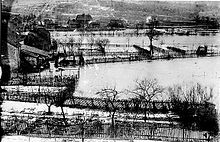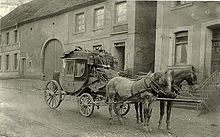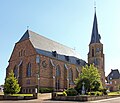Lebach
| coat of arms | Germany map | |
|---|---|---|
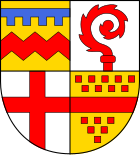
|
Coordinates: 49 ° 25 ' N , 6 ° 55' E |
|
| Basic data | ||
| State : | Saarland | |
| County : | Saarlouis | |
| Height : | 275 m above sea level NHN | |
| Area : | 64.15 km 2 | |
| Residents: | 19,073 (Dec. 31, 2019) | |
| Population density : | 297 inhabitants per km 2 | |
| Postal code : | 66822 | |
| Primaries : | 06881, 06888 , 06887 | |
| License plate : | SLS | |
| Community key : | 10 0 44 112 | |
| Website : | ||
| Mayor : | Klauspeter Brill (independent) | |
| Location of the city of Lebach in the Saarlouis district | ||
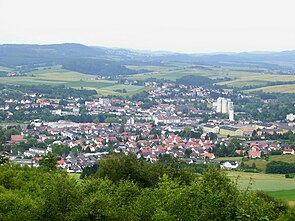
Lebach ( ) is a town in the Saarlouis district in the Saarland .
geography
Geographical location
Lebach is located in the middle of the Saarland in the undulating Saar-Nahe-Bergland , at 6 ° 55 '0 "longitude and 49 ° 23' 60" wide. The geographical center of the Saarland was determined in the district of Falscheid .
mountains
- Bolzenberg 294 m
- Hangenberg 300 m
- Hetschberg 304 m
- Hoxberg 415 m
- Wünschberg 294 m
- Donnerhübel (Steinbach) 452.1 m
- Höll (Steinbach) 453.5 m
- On the Lindenberg (Steinbach) 460.6 m
Waters
The Theel rises from a headwaters in the Theley district on the northern slope of the Schaumberg and flows through the villages of Bergweiler and Sotzweiler of the municipality of Tholey and in the city of Lebach through the districts of Thalexweiler , Aschbach and Lebach, where it has several tributaries until it reaches Nalbach - Körprich in the prims flows.
The Merten raft rises near the Weierberg. After several hundred meters it joins Theel at Tholeyer Strasse.
The Mandelbach rises in Landsweiler, flows along the Saarbrücker Straße and flows into the Theel.
Neighboring communities
Clockwise starting in the north : Tholey , Eppelborn , Heusweiler , Saarwellingen , Nalbach , Schmelz .
Residents
| Population development | |||||||||||
|---|---|---|---|---|---|---|---|---|---|---|---|
| year | 1998 | 2000 | 2002 | 2004 | 2006 | 2008 | 2010 | 2011 | 2012 | 2015 | 2017 |
| Residents | 21,679 | 21,060 | 21,540 | 21,254 | 20,388 | 19,962 | 19,784 | 19,763 | 19,456 | 19,156 | 18,977 |
(as of December 31st)
history
Celtic settlement traces are from the 3rd century BC. Known. Two Roman villas with cemeteries and a so-called sacrificial pond are evidence of Roman settlement. From the 4th century Germanic tribes settled in Lebach .

The first documentary mention of Lebach (as Leibach ) comes from a list of parishes in the pilgrimage register of the Mettlach Monastery from the year 950.
During the Middle Ages Lebach came under the rule of the archbishops of Trier , the Lords of Hagen with the place in the late Middle Ages mortgaged . According to a document dated September 8, 1614, Lebach formed a so-called Vierherrschaft together with Landsweiler and Niedersaubach : Kurtrier , the Lords of Hagen zur Motten and the Duchy of Lorraine each held two-sevenths of the shares in market law and jurisdiction ; the abbess von Fraulautern held a seventh . In 1787 the Duchy of Pfalz-Zweibrücken took over the Lorraine shares in the four-rule Lebach.
Due to the rich iron ore deposits in the form of Lebach eggs , Lebach experienced an economic boom in the 17th and 18th centuries and, due to its geographical location, Lebach increasingly developed into a transport hub.
The French occupation of all areas on the left bank of the Rhine after the beginning of the French Revolution also ended the four-rule rule in 1794. In 1798 Lebach was added to the Saar-Département and raised there to the canton location, to which the mayorships of Hüttersdorf, Lebach, Nalbach, Saarwellingen, Schwalbach, Sellerbach (today Riegelsberg), Heusweiler, Quiiev and Dirmingen were assigned.

After the Paris Peace of 1814 , the greater part of the Lebach canton fell to Prussia; the place Lebach initially belonged to the district of Ottweiler , from July 1816 to the district of Saarlouis of the Prussian province of the Grand Duchy of Lower Rhine , which became part of the Rhine province in 1822.
In winter 1902/03 was rampant in the room Lebach typhoid , which could spread mainly by inadequate water and sanitation.
Lebach was an important stage during the Second World War. Many refugees from the Saar Valley came to Lebach during the war. Lebach was also an important transit point for troops who took up positions on the Siegfried Line or in the front line. On January 9, 1944, bombers attacked Lebach as an important traffic junction and replenishment point, but missed their targets - the main roads and railway systems - because of a closed cloud cover.
After the Second World War Lebach was under French occupation. When the Allied troops reached the German border and the US troops were fighting for bridges in the Saarland, the Lebach citizens were asked to leave the city and move to safer places away from the fighting. Ultimately, 600 of the 2,900 inhabitants stayed in the city. In autumn 1944, more and more wounded soldiers were brought to the Lebach barracks. Heavy bombing of the city by the Allies followed in December 1944. On March 18, 1945, the Americans entered Lebach. On July 10, 1945, the US occupation forces were replaced by French soldiers.
In the post-war period, a high school and a teachers' college were built in the empty Lebach barracks. The central refugee camp and the barracks of the paratrooper battalion followed later. The place gained nationwide attention in 1969 with the so-called Lebach soldier murder .
On June 1, 1977 the municipality Lebach received city rights.
Incorporations
As part of the regional and administrative reform in Saarland , the eleven independent municipalities of Aschbach , Dörsdorf , Eidenborn , Falscheid , Gresaubach , Knorscheid , Landsweiler bei Lebach, Lebach, Niedersaubach (with Rümmelbach, which was incorporated in September 1964), Steinbach via Lebach and Thalexweiler am 1 January 1974 merged to form a new community under the name Lebach.
Place name
The name Lebach possibly goes back to a common (Gallo-) Roman type of name for manors. The ending -ach often goes in settlement names to the Gallo-Roman usual settlement area besitzeranzeigende suffix - (i) acum / - (i) acus (add: fundus or praedium , that is.. Estate ) back to what an early name similar Leviacum (see Léojac in. France ) suggests. Hans Bahlow (Germany's geographical world of names), on the other hand, is based on a water body name and mentions Laubach (near Wittlich ) and Leberbach (near Heppenheim ) as well as a river Leber in the Vosges .
politics
City council
The city council is the municipal representative of the city of Lebach. The citizens decide on the composition every five years. The last election took place on May 26, 2019.
Parties
- CDU City Association Lebach; it includes ten local associations in the city of Lebach.
- SPD City Association Lebach; eight local chapters belong to it.
- FDP City Association Lebach; he has four local chapters.
- Bündnis 90 / Die Grünen Saarland, local association Lebach
- JU City Association Lebach; he has five local chapters.
mayor
- 1978-2006: Nikolaus Jung, CDU († August 27, 2013)
- 2006–2012: Arno Schmidt, CDU († December 20, 2012)
- since 2013: Klauspeter Brill, non-party
On January 22, 2006, Arno Schmidt (CDU) won the mayoral election against Jürgen Barke (SPD) with around 55% of the vote. He was Nikolaus Jung's successor since October 2006. Arno Schmidt died on December 20, 2012 at the age of 60. Klauspeter Brill won the election for mayor on May 26, 2013 as a non-party candidate with almost 74% of the votes in the second ballot.
coat of arms

|
Blazon : "Square, in 1 in gold a red zigzag bar , surmounted by a continuous, four-lipped, blue tournament collar, in 2 in silver a growing left-facing red crook , in 3 in silver a continuous red cross and in 4 in gold a red bar, accompanied above by nine (5: 4) and below (3: 2: 1) by six red shingles. "
Declaration of coat of arms: Until the French Revolution, Lebach was a so-called four - rule , and so the coat of arms is also four - sided with those of the rulers (divided into four fields):
- Feld: A share (2/7) was in the possession of the Lords of Siersberg and Dillingen for a long time , fell to the Braubach family through inheritance in 1548, came to the Duchy of Lorraine in 1613 and with this to the Kingdom of France in 1768 , until 1786 in Exchange was assigned to the Duchy of Pfalz-Zweibrücken . Since the first-mentioned family had owned this share the longest, their coat of arms was shown in the first field.
- Feld: The Abbey Fraulautern held 1/7 of the rule until the French Revolution. Since she did not have her own coat of arms, an abbess crook was added to the second field .
- Feld: The Archbishopric of Trier owned another 2/7 .
- Feld: The remaining 2/7 belonged to the Barons von Hagen zum Motten .
Town twinning
Since May 20, 1979 there has been a town partnership with the French city of Bitche in the Moselle department .
Economy and Infrastructure
traffic
Road traffic
Lebach is connected to the national road network via the federal highways 10 (to Augsburg ), 268 and 269 . The nearest motorway connections are for the A 8 Heusweiler (7 km) and Nalbach (10 km) and for the A 1 Eppelborn (5 km) and Tholey (8 km).
Local public transport (ÖPNV)
Role as a transfer hub
Lebach is an important hub in the regional bus network. Saarbahns continue every quarter of an hour on the S1 line and on the Primstalbahn regional trains on the RB 72 line to Saarbrücken. Four large regional bus routes run every hour in all four directions with a connection to the DB trains that run in the larger stations in Dillingen / Saar , Saarlouis , St. Wendel , Völklingen and Saarbrücken and are so interlinked that you can move seamlessly from one to the other other line can change. These lines run from early in the morning until late at night and allow some leisure activities on the weekends. On weekends and on public holidays, the lines run every two hours (the Saarbahn, however, as during the week, every half hour, on Sundays every hour). Due to Lebach's location and the extensive range of trips, all major Saarland cities can be reached in 45 minutes at the most by public transport. Due to the integration into the SaarVV transport association, only one ticket is required for all journeys, which entitles you to use all means of transport, regardless of whether regional bus, city bus, train or Saarbahn.
Authorities
Lebach is a site of the Land Administration Office (LAVA) on which the department two central immigration office (until 2008 independently as State Office for Immigration and Refugees Affairs ), the reception center (popularly known as "country residential development" / "camp") which anchor device is , the immigration authority Lebach and the legal affairs, clearing and objection office are located. The Federal Office for Migration and Refugees has a branch in the AnkER facility in Lebach. The Land Development Department of the State Office for Surveying, Geoinformation and Land Development is also located in Lebach and is responsible for land consolidation nationwide . Lebach also housed the Saarland Chamber of Agriculture as the “green center” until they moved to Bexbach .
dishes
Lebach has a local court , which the district court - and OLG -Bezirk Saarbrücken belongs. Next to the office building of the district court is the only youth detention center in Saarland, in which (equipped with 30 detention places) sentences between two days and four weeks can be served.
military
Lebach was the location of the paratrooper battalion 261 of the airborne brigade 26 until 2015 ; the garrison in the Graf-Haeseler barracks comprised around 1200 soldiers. Lebach is still a location of the Bundeswehr for the airborne reconnaissance company 260 and the telecommunications company of the multinational Eurocorps .
Health care
- ctt hospital with standard care , 202 beds with the departments of trauma surgery, general surgery, plastic surgery, internal medicine (hematology, oncology), intensive care medicine, anesthesiology, radiology with computed tomography
- Psychiatric day clinic (around 20 places) in Friedensstrasse belonging to St. Nikolaus Hospital Wallerfangen
education
Day care centers
- Aschbach day care center
- Day care center Dörsdorf
- Lebach day care center
- Steinbach daycare center
- Daycare center Thalexweiler
- Kindergarten Herz-Jesu Gresaubach
- cath. Kindergarten St. Donatus, Landsweiler
- cath. Kindergarten Hl. Dreifaltigkeit und St. Marien, Lebach
- Day care center “St. Nikolaus ”, Lebach
Elementary schools
- Landsweiler primary school
- Lebach primary school
- Elementary school Steinbach
- Nikolaus-Groß-Schule Lebach
High schools
- Geschwister-Scholl-Gymnasium Lebach
- Johannes-Kepler-Gymnasium Lebach
Community schools
- Theeltal School Lebach
- Nikolaus-Groß-Schule Lebach
Vocational school
- BBZ Lebach
Markets
Weekly market
The largest weekly market in southwest Germany takes place in Lebach every Thursday. This market has a centuries-old tradition. Lebach was able to become a market center because its convenient location makes it a junction of various important roads. First stagecoach lines were set up to Lebach, later railway lines were built.
Mary's birth market
During the “Green Week” in Lebach, the Marian Birth Market takes place on the Tuesday after the second Sunday in September, a market with almost 500 stalls, to which thousands of visitors come to Lebach.
A thousand years ago there was a church in Lebach on the site of today's Catholic parish church, which was consecrated to Mary, the Mother of God. The patronage festival was celebrated with a large cattle and junk market. The first known document attesting to the fair dates from 1614.
Other markets
There is a Christmas and an Easter market as well as an autumn and farmers market in the third week of October.
Culture and sights
Culture
carnival
The Lebach Carnival (also popularly known as Faasend ) is organized annually by the Lebach Carnival Association (CVL). The highlights of every carnival session are the costume cap sessions in the Lebach town hall. On Fat Thursday , the city hall storm follows, during which the prince couple takes over the reign of the city hall. On Shrove Tuesday, important Lebach residents are "arrested" and brought to the town hall, where they can celebrate with the Carnival Association and eat free of charge for a deposit. On Shrove Tuesday, the session ends with a large street parade through Lebach city center. The Catholic women's community in Germany organizes three “Colorful Evenings” every year at Lebacher Faasend. Both clubs together are the linchpin of Lebacher Faasend.
Green Week
Every year in the second week of September the city of Lebach organizes the "Green Week". A cattle market was held on the "Feast of the Name of Mary" as early as the 17th century. This has been enlarged over the years and since 1921 there has been a horse race following the market. Today there is also a supporting program with various events, u. a. in the marquee.
Attractions
- Grave field from the Latène period ( Mediomatriker )
- Kaltenstein (near Lebach / Zollstock)
- Center of the Saarland (near Falscheid )
- La Motte Castle
- catholic parish church Holy Trinity and St. Marien (Lebach)
- Town hall with fountain in the city
- Asian garden
See also: List of architectural monuments in Lebach
Religious communities
Catholic Church
The Catholic parish of the Holy Trinity and St. Mary in the center of Lebach belongs to the diocese of Trier . In Lebach itself there are about 7,000 Catholics, in the parishes of Landsweiler and Falscheid, which also belong to the Lebach parish, there are 1,800 and 520 Catholics respectively. In addition, there are Catholic churches or chapels in the districts that belong to Lebach.
- Catholic churches and chapels in Lebach
Protestant church
The Protestant parish Lebach belongs to the " Evangelical Church in the Rhineland " and was founded in 1906. The parish currently has around 2750 members (2010). Pastor is Andrea Sattler. After the Reformation, the Evangelical Church in Lebach could not assert itself after Protestant services were banned by the Lorraine overlords. From 1852, Protestant services were held again in the courtroom of the Lebach local court . In 1906 the foundation stone was laid for a Protestant church in Lebach, which was completed in 1907.
Other Christian denominations
In addition to these two churches, there are also free churches in Lebach , including a Free Evangelical Congregation and a house of prayer for the Evangelical Christians-Baptists .
Judaism
Lebach had only a very small number of Jewish residents in its history. By 1920 Lebach had 12 Jewish believers who belonged to the Hanau, Oppenheimer and Stern families.
Trivia
With the so-called soldier murder of Lebach , which led to the establishment of the Lebach network in the Bundeswehr , Lebach gained national media interest in 1969. The dispute over documentary processing in film and television (productions from 1972 and 1996), which moved in the area of tension between freedom of broadcasting and the perpetrators' personal rights, went down in German legal history as the Lebach judgment of the Federal Constitutional Court .
One of the masterminds behind the attacks on March 11, 2004 in Madrid spent some time in the state housing estate in Lebach.
Personalities
sons and daughters of the town
- Maria Honorine Steimer (1831–1903), first Superior General of the Redeemer Sisters
- Jacob Weber (1872–1944), politician
- Theodor Gansen (1887–1956), painter of the Düsseldorf School, restorer and art forger
- Gottfried Müller (1910–1991), economist and spatial planner
- Klaus Altmeyer (1926–2020), journalist and publicist
- Herbert Strässer (1930–2005), sculptor
- Georg Jenal (* 1942), historian
- Monika Schwinn (* 1942), honorary citizen, nurse captured during the Vietnam War
- Christoph Kühn (* 1964), politician, member of the Saarland state parliament
- Armin Dewes (* 1979), volleyball player
- Nadine Schön (* 1983), politician (CDU), Member of the Bundestag since 2009
- Philipp Schug (* 1983), jazz musician
- Aileen Frisch (* 1992), luge rider
- Joshua Mees (* 1996), soccer player
- Florian Müller (* 1997), soccer player
Personalities who work, worked or died on site
- Emma Stern (1878–1969), businesswoman and painter
- Albert Baldauf (1917–1991), politician (CDU), died in Lebach
- Werner Bauer (* 1934), light and kinetics artist, was an art teacher in Lebach from 1964
- Klaus Steinbach (* 1953), swimming athlete and sports official, lives in Lebach
- Gabriele Klara Schäfer (* 1957), politician (CDU), worked at the counseling center of the social service for Catholic women and then until 1994 at the education, marriage, family and life counseling center in Lebach
Individual evidence
- ↑ Saarland.de - Official population figures as of December 31, 2019 (PDF; 20 kB) ( help ).
- ↑ Hans-Henning Krämer, From the village fountain to the waterworks. History of drinking water supply on the Saar , Gollenstein Verlag 1999, ISBN 3-933389-07-0 , p. 128 ff.
- ^ [1] History of the JKG Lebach
- ↑ a b Federal Statistical Office (ed.): Historical municipality register for the Federal Republic of Germany. Name, border and key number changes in municipalities, counties and administrative districts from May 27, 1970 to December 31, 1982 . W. Kohlhammer, Stuttgart / Mainz 1983, ISBN 3-17-003263-1 , p. 807 f .
- ^ Community result Lebach, final result of the municipal council elections 2019 at: www.wahlresult.saarland.de, accessed on May 26, 2019
- ↑ www.saarbruecker-zeitung.de ( Memento of the original from October 28, 2013 in the Internet Archive ) Info: The archive link was inserted automatically and has not yet been checked. Please check the original and archive link according to the instructions and then remove this notice.
- ^ City of Lebach: City of Lebach - day care centers. Retrieved June 19, 2018 .
- ↑ a b c d City of Lebach: City of Lebach - schools. Retrieved June 19, 2018 .
- ↑ Cf. Gudrun Gerlach: The grave field 'Die Motte' near Lebach. Vol. 1: Catalog. Bonn: Habelt, 1976 (Saarbrücker contributions to antiquity, volume 16), ISBN 3-7749-1351-X ; Vol. 2: Text. Bonn: Habelt 1986 (Saarbrücker Contributions to Archeology, Volume 15). ISBN 3-7749-1350-1 .
- ↑ "There was the word of Vietnam" . In: Der Spiegel . No. 13 , 1973 ( online - Mar. 26, 1973 ).
- ↑ Emma Stern in the Saarland Biographies
literature
- Johannes Dillinger: From the Stone Age to the 21st Century, The History of the City of Lebach, ed. from the historical association Lebach eV, Merzig 2016.
- Franz-Rudolf Repplinger and Jutta Arnold: Vierherrschaft Lebach, ed. from the Volkshochschule Lebach e. V., Nalbach 1991.
- Friedrich Toepfer: Supplements III. The gentlemen of Hagen . In: ders. (Ed.): Document book for the history of the royal and baronial house of the Voegte von Hunolstein , vol. I. Jacob Zeiser, Nuremberg 1866, pp. 304–306 ( Google Books )
- Ilse Winter-Emden: History of the Lebach ore mines and their importance for the region, with a contribution by Dieter Schweiss: On the trail of the Permian Age, The Saar-Palatinate Rotliegend Age, ed. from the Volkshochschule Lebach, Lebach 1995.
Web links
- City of Lebach
- Literature about Lebach in the Saarland Bibliography
- Link catalog on Lebach at curlie.org (formerly DMOZ )



